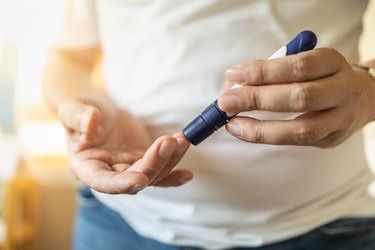
The rate of new diabetes diagnoses has been steadily rising in the U.S. Currently, more than 100 million American adults are living with diabetes or prediabetes, according the Centers for Disease Control and Prevention (CDC).
Controlling blood sugar is key to managing the disease, but even if you haven't been diagnosed with diabetes, your blood sugar levels might give you some insight into your health. Catching a high blood sugar reading earlier rather than later, for example, can help you better treat any potential or growing concerns.
Video of the Day
Video of the Day
Read more: What to Eat to Feel Better — Inside and Out
What Are Normal Blood Glucose Levels?
Your blood glucose, or blood sugar, is the main sugar found in your blood, according to the U.S. National Library of Medicine. Blood glucose comes from food and provides your body with energy. Your levels may rise and fall throughout the day, depending on what and when you eat.
Normal blood glucose levels, regardless of gender, are between 70 and 99 milligrams per deciliter (mg/dL) if the test is taken fasted, according to Virginia Mason Medical Center. Two hours after eating, a normal blood sugar level is anything below 140 mg/dL.
Testing Your Blood Glucose
The glycated hemoglobin or A1C test is a blood test that estimates your average blood glucose levels for the two- to three-month period prior to the lab draw, according to the Mayo Clinic. This test doesn't require fasting and gives your physician an idea of how well you are managing your blood glucose. Ideally, for men and women, your A1C should be below 5.7 percent. Values between 5.7 and 6.4 percent indicate potential pre-diabetes.
Another common way to test your blood sugar levels is a fasting glucose test, taken at your doctor's office, according to the Mayo Clinic. This test is done before you've had anything to eat in the previous eight to 12 hours. You may also take a random blood sugar test, which is a blood sample taken at a random time. Any random blood sugar level of 200 mg/dL or higher indicates potential diabetes.
What If Your Blood Sugar Levels Are Too High?
Blood sugar levels that stay very high can eventually lead to diabetes complications with the kidneys, feet and eyes, according to the National Library of Medicine. While there are some differences between type 1 and type 2 diabetes, both are characterized by high levels of glucose in the bloodstream, according to the Mayo Clinic.
Patients diagnosed with diabetes are encouraged to practice healthy eating and get regular physical activity in order to maintain a healthy weight, according to the Mayo Clinic. It's also important to stay hydrated, since dehydration can affect blood glucose levels, causing a spike, per the CDC.
Treatment for type 1 diabetes involves insulin injections and frequent blood-sugar checks. On the other hand, treatment of type 2 diabetes usually requires lifestyle change and diabetes medication or insulin, if prescribed by a doctor.
Read more: Is Your Doctor Missing What's Wrong With You?
Is this an emergency? If you are experiencing serious medical symptoms, please see the National Library of Medicine’s list of signs you need emergency medical attention or call 911.